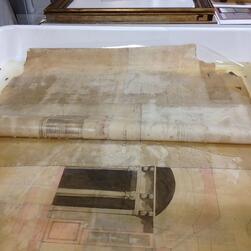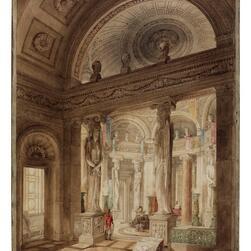An exciting and unexpected discovery, made while the conservation team were treating works of art for the restoration project, is reported here by Head of Conservation Jane Wilkinson
As part of phase two of the OUTS project we are carrying out conservation on the framed works from the North Drawing Room: assessing the works and their frames, and cleaning and repairing them where necessary. During the week before Christmas 2013, we opened up the frame of Interior of a Sepulchral Chapel for the Duke of York, 1827 (P282) by Joseph Michael Gandy, which appeared never to have been opened since it was framed in the 1820s. We found the watercolour had been attached to a piece of canvas and placed on a stretcher – as if it was an oil painting. This was not so surprising as it is something we have found with other watercolours here, however, more intriguingly, we discovered that the back of the stretcher had been protected with layers of what looked like scraps of paper, all pasted to each other to create a kind of papier-mâché board. Because we thought there might be something on the undersides of the scraps, we decided to separate the pieces. Lorraine Bryant, our paper conservation consultant, first removed the ‘papier-mâché’ board, using poultices, in this instance, a jelly-like substance applied to the paper to soften the adhesive. This was a very delicate, lengthy and tricky process. Lorraine then humidified the pasted sheets in a bath of water to separate them.
Imagine our delight when we discovered that there were twelve separate pieces of paper, all of which had architectural drawings on them! In some instances sheets had drawings on both sides. There were plans, elevations and sketches, all evidently from Soane’s own drawing office. Apart from the thrill of this discovery of previously unknown drawings the find has also provided new insights into the workings of the office, showing that Soane used his students to frame works for him in the Office, and that drawings for schemes were readily discarded when superseded by new designs. The drawings are for the Bank of England, the museum itself and other schemes not yet identified. It’s interesting to note that paper, an expensive material in the Regency period, was often carefully re-used. The point of covering the back of the stretcher in this way seems to have been to protect the Gandy watercolour, and this was successful as the back of the canvas supporting the work has remained very clean, and the watercolour is in good condition. This method of backing the canvas seems to have given greater protection against pollutants than the more common way of framing watercolours with wooden backboards.
Over the next few months the drawings will all be identified and catalogued, so watch this space for further updates. We will be posting regular bulletins about these and all the other drawings we have unearthed from the backs of several more Gandy watercolours.


